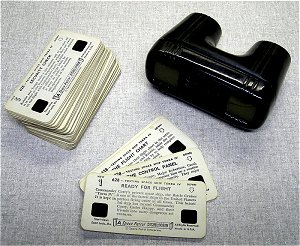|




























|
 |


Stereoscopes, 3D Viewers,
and Post Card Projectors

Some of my collection of different optical viewers and projectors.
(When viewing larger photos use your browsers back button to return to this page)
Stereoview Cards
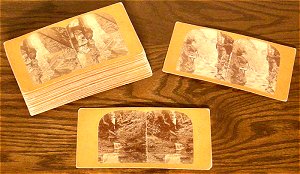 |
In 1844 David Brewster introduced a device for taking 3D photographs. He called the device the Stereoscope.
To view the 3D effect you place a card with two photographs on it in one of the stereoviewers below.
Pictured at left is a set of around 50 Stereoview Cards taken of the climb through Watkins Glen in the 1800s.
A note found with this set says they were purchased on an excursion to Watkins Glen N.Y. on July 4, 1883 by Howard Ellis
as a gift to his soon to be wife. (note below).
Watkins Glen Cards - Larger Photo
Watkins Glen Cards note
Stereoview Card Example - Sears Stockroom (Talking Machine Records)
|
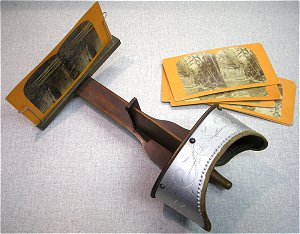 |
Keystone Stereoscope
A typical Stereoscope has a sliding holder for bringing a stereoview card into focus.
This Stereoviewer is from the early 20th centuary. It was manufactured by the Keystone View Company, Meadvill, PA.
Larger Photo
|
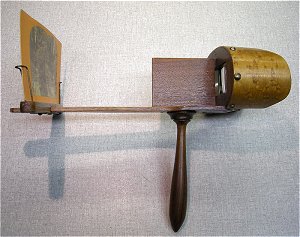 |
Unknown Stereoscope
There is no manufacturer marked on this wooden viewer. The only stamp it has reads
"Pat'd Dec. 1, 1863 Reissued May 7, 1878".
Larger Photo
Larger Photo
|
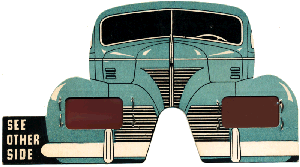 |
1939 Worlds Fair Chrysler 3D Glasses
These 3D glasses were handed out by Chrysler to view their "In Tune With Tomorrow" 3D movie at the 1939 Worlds Fair.
These were reportedly the first "Polerized" 3D glasses.
Larger Photo - Front
Larger Photo - Rear
|
 |
View-Master 3D Viewer
The classic bakelite Viewmaster 3D viewer I grew up with along with three of my Saturday morning TV favorite View-Master reels from the 1950s, Hopalong Cassidy,
the Cisco Kid, and my all time favorite cowboy, Roy Rogers and his horse Trigger.
View-Master Larger Photo
View-Master Reels
Roy Rogers and Trigger
|
 |
View-Master Junior Projector
This View-Master Junior Projector was used to project reel slides onto the wall (not in 3D).
|
 |
Radioptican Post Card Projector
The radioptican was designed to reflect light
off a post card through a focusing lens and onto a wall. They only work if used in total darkness.
You slide a post card into a holder on the back and the light inside reflects off the card and projects the image onto the wall.
This Radioptican came with two rear doors so you can be reloading a post card in one while others are viewing the first post card.
Early projectors were gas flame powered as electricity was not available yet. In the 1920s a kit was available to convert to electric lamps.
Many when found still have the early Edison screw connector for connecting to a lamp socket (mid 1920s).
The two chimneys on the top are to expel the heat from the flame or the lamps.
Larger Photo
Edison Connector
|
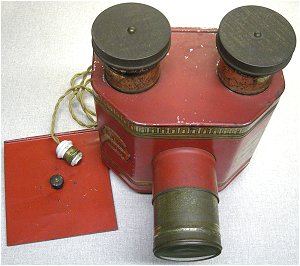 |
Radio Junior Post Card Projector
This is a smaller version of the Radioptican projector shown above.
Notice the Edison power connector which dates this projector around the mid 1920s.
Larger Photo
Label
|
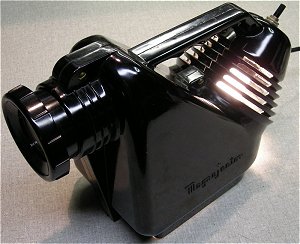 |
Magnajector
The Magnajector used a standard incandescent bulb and was designed to project small objects and flat items like photographs, books and magazines onto a wall. Later versions came with flash cards and other learning materials.
This model MJ100 was distributed by Rainbow Crafts Inc..
Larger Photo
Bottom
|
 |
Seerite Opaque Projector
This Seerite Opaque Projector is is a modern version of antique Radioptican Post Card Projector above. It's designed to project photographs, books, and artwork onto a wall.
This model 441D was distributed by Testrite Instrument Co.
Larger Photo
Back
Badge
|
|
|







